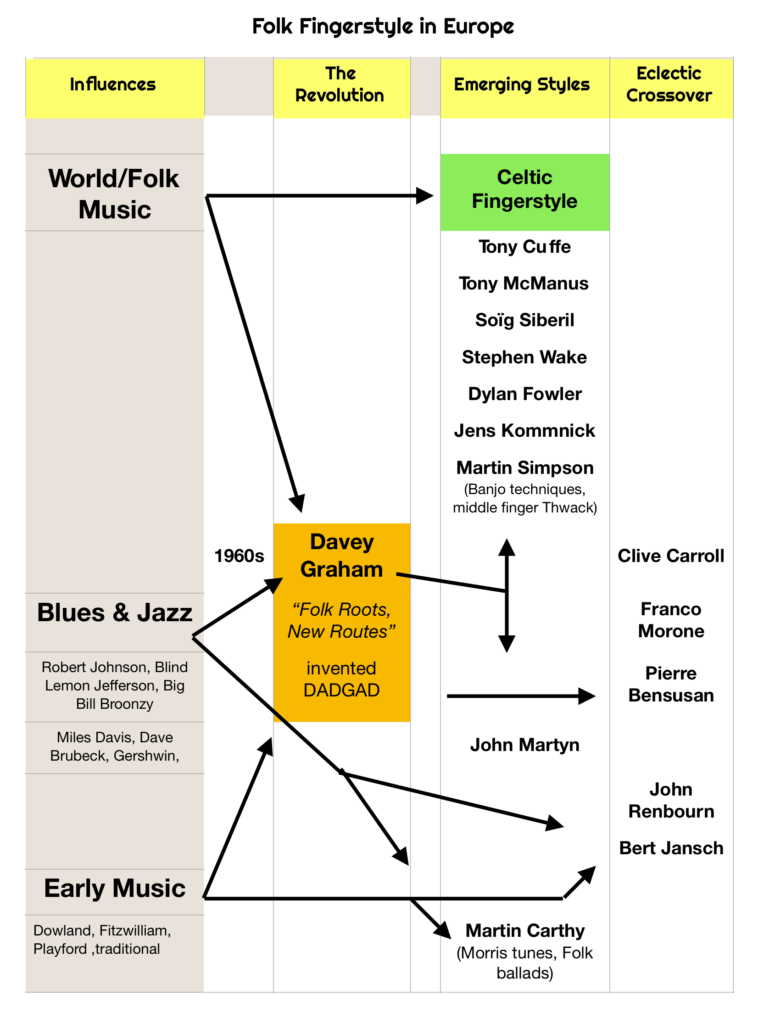How would you define Folk-Fingerstyle Guitar?
It is hard to pin down exactly what fingerstyle guitar is, given how many styles it encompasses, but – as the name suggests – the bottom line is one plucks with fingers and thumb as opposed to using a plectrum. This would still encompass classical guitar, flamenco and fingerstyle-jazz, but it most often associated with (mainly) steel-string guitars playing folk, folk-blues and all the variations thereof ….
Development of fingerstyle guitar in Britain and Europe
What follows is an inevitably subjective and very condensed view of folk fingerstyle as I got to know it, which will hopefully serve as inspiration for one’s own further exploration and research. Don’t despair if I didn’t mention someone, who you think should be included, this is an attempt to give a starting point, an overview of the development of folk fingerstyle guitar in Britain and Europe.

The 1960’s and what they meant for fingerstyle guitarists
The 1960’s must have been an exciting time: the “folk boom” was blossoming, blues and jazz festivals were springing up in Britain, and one had to the chance to see some of the legendary American players live. The famous British folksinger and guitarist Martin Carthy might not have developed his punchy rhythmic style had he not heard the music of Big Bill Broonzy or Elizabeth Cotten (whom he cites as influences). The masterpiece album of jazz trumpeter and bandleader Miles Davis, “Kind of Blue” was released in August 1959. Regarded as one of the most influential albums of all time, it is no surprise to hear that the legendary folk-jazz group Pentangle (including fingerstyle guitar icons John Renbourn & Bert Jansch)
fell under it’s spell (just listen to “All Blues” by Miles Davis, and then “I’ve got a feeling” by Pentangle … :-).
Davey Graham and Anji – a new era
A major event happened In 1962: a British guitarist named Davey Graham, after hearing an oud (a fretless Arabian lute-type instrument), invented the tuning DADGAD, and so heralded in a new era in folk music. This would become – among other things – a favourite tuning of many guitarists working in Celtic music. The album “Folk Blues and Beyond” was a milestone, as was the album with singer Shirley Collins – “Folk Routes, New Routes“. Elements of British folk, Eastern music, jazz and blues combined in a completely new way on an acoustic guitar. This heavily influenced all British guitarists, but notably Renbourn and Jansch (whose intricate arrangements and playing got the title of “folk baroque”) and also Jimmy Page. Davey Graham’s iconic instrumental piece “Anji”, with it’s walking bass and bluesy feel, became a sort of unofficial test piece. In the 70’s, you couldn’t call yourself a fingerstyle guitarist unless you could play Anji.
DADGAD tuning in Folk/Celtic Fingerstyle
Folk and fingerstyle guitar was developing. DADGAD opened up amazing new possibilities for accompaniment but players were generally experimenting more and more with melody, so that over the next decades the guitar also emerged as a solo instrument.
The Irish guitarist Mícheál Ó Domhnaill brought DADGAD guitar into the limelight playing with e.g. the Bothy Band –
this in turn inspired the Breton Virtuoso Soïg Siberil, who was at the forefront of new Breton folk as a band member in various projects and as a soloist.
I have the pleasure and honour of playing with Soïg in the trio Celtic Guitar Journeys, alongside Welsh maestro Dylan Fowler, who plays DADGAD a whole step down i.e. CGCFGC, which gives a very rich and sonorous sound.
DADGAD became the “standard tuning” of French guitar maestro Pierre Bensusan, exploring all sorts of world music at a very high level of eclectic virtuosity.
In the nineties in Scotland the great guitarist Tony McManus showed how Scottish bagpipe and fiddle music could be successfully translated onto the guitar. John Renbourn hailed Tony as “the best Celtic guitarist in the world” – high praise indeed!
Clive Carroll and Franco Morone are two guitarists who spring to mind as regards – seemingly effortlessly – spanning different styles. Well worth checking out!
I think one can generally say that the really good and interesting players often draw on lots of influences. I’ve spoken a lot about DADGAD, but of course many tunings – as well as good ol’ standard tuning – were and still are being used. The Celtic Fingerstyle players also often show influences from jazz, blues, classical and rock music, while still maintaining a respect and deep understanding of their corresponding traditions. This quote attributed to Gustav Mahler I find immensely appropriate: “Tradition is not the worship of ashes but the preservation of the fire.”
Ian Melrose